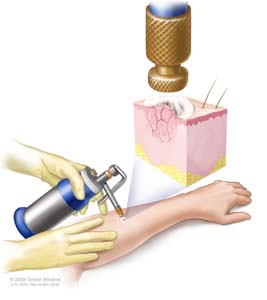Cryosurgery’s dictionary definition is: “The selective exposure of tissues to extreme cold, often by applying a probe containing liquid nitrogen, to bring about the destruction or elimination of abnormal cells" (19). This definition gives a quite simple explanation of Cryosurgery, but it’s impact goes far beyond its definition. Although relatively new, the technique of freezing tissue is becoming more widely known in and out of the field of Cryobiology as it is used to treat tumors, control pain, and control bleeding. The cold is introduced through a probe which has liquid nitrogen circulating through it. The tissue is frozen to below -200 degrees Celsius in order to destroy it and prevent disease and growths. Milder treatments are done by using nitrogen at a less extreme temperature to prevent tissue damage and keep the surrounding tissue healthy (11). In milder cases, Cryosurgery destroys a variety of benign skin growths including warts, pre-cancerous lesions, and malignant lesions. Cryosurgery is also implemented for tumors of the “prostate, liver, lung, breast, and brain as well as for cataracts, gynecological problems, and other diseases” (10). Cryosurgery’s ultimate purpose is to destroy harmful or unwanted growths through freezing while maintaining the healthy surrounding skin in a way that prevents injury to healthy tissue (10). While Cryosurgery is not a treatment for cervical cancer at the present time, it is used on abnormal cervical cells by freezing certain sections of the cervix. These precancerous cells are frozen and then considered unharmful in order to prevent a future possibility of cervical cancer (18). A controlled freezing of the prostate is now an alternative treatment for those with prostate cancer. Cryosurgery in the prostate is now an alternative whose results are more effective than current standard treatment processes. “In prostatectomy, a very low-temperature probe freezes and thereby destroy prostatic tissue. The metal probe is set at the center of the tumor where the liquid nitrogen is then circulated” (9).While risks do accompany this treatment, its failure rate is below 15% for all patients and has even been recorded as assisting those with failed radiation treatment. Cryobiology is relatively new to the field of biology, so the long term effects cannot be devised for years to come, but the results look promising. Besides the treatment of prostate cancer, it is being used to treat patients with problems in other organs such as the liver, pancreas, and kidney. |
 A form of cryosurgery used to destroy abnormal tissue. Figure 5
Cryosurgery in Treating Prostate Cancer. Multimedia 2 |